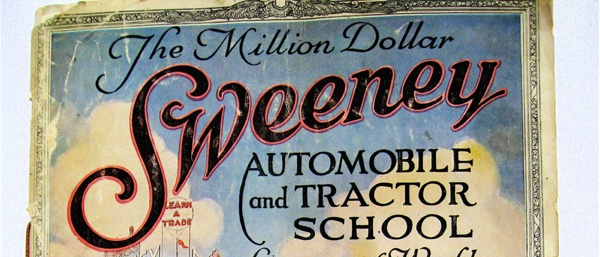
Emory Sweeney founded the Sweeney Automobile and Tractor School, in May of 1908 in Kansas City, MO with just five students enrolled. Started on a shoestring, the enrollment fees collected from the first five students were used to rent a building and buy teaching supplies for a month.
Emory himself had learned the automotive repair trade by working in an automobile garage for a year. After that year he decided he had garnered enough experience that he could teach others the trade. So he ran an advertisement in the Kansas City Star newspaper offering to teach, “Impressionable young men the trade of automobile, repair…”
Enrollment increased rapidly during World War I, which created a demand for more space. With a bright future ahead Emory designed and had built a 10-story high-rise building constructed directly across from the railroad’s Union Station on Pershing Road in Kansas City.
Emory advertised the new “million dollar” school as large enough to house and teach 800 students. Indeed it was big, with 12 acres of floor space, and an Olympic size swimming pool in the basement. The building was completely self-sufficient having its own electrical generation station, heating and cooling systems in the basement.
The building was advertised as having the largest dining room and kitchen in the world. Emory bragged that you could park a full size car in each of the three freezers in the kitchen area. There was also a bank and a post office on site.
The most impressive part of the building and the part that became a Kansas City landmark was the lighted sign on top of the building. The sign towered 80 feet above the top of the already towering 10-story building and contained 5,000 electric lamps.
By 1917, the year the 10-story building was dedicated, enrollment at the school was 3,674 students. By 1919 enrollment was up to 7,197 students.
Cost of Enrollment

To take the eight-week class in 1920 would cost a student $150.00. There were no books to buy; you learned everything hands-on with instructors there to guide you. That was the “Sweeney Method” of teaching. In addition the cost of room and board was eight dollars a week if you stayed at the school, and it was suggested that you also bring two dollars a week for personal entertainment expenses. No alcohol was allowed on the premises.
The school was open every day, year around, 24 hours a day. Students could work in the school garage working on customer’s cars for extra credit and experience under an instructor’s guidance.
Just when you think a guy like Emory had enough irons in the fire there is more. He also wrote a 72-page catalog every year that showed all of the classes available and what a student could expect to learn during his time at the Sweeney School. Everything was covered including testimonials from past students (updated annually) who had become successful after attending the Sweeney School. Oh…And Emory and his wife also had nine children together during these years.
A Radio Station
Also established at the Sweeney building was Kansas City’s first radio station, “WHB”, which is still on the air today.
The radio station was for local programming including time each day, when Emory talked about his million-dollar school and presented interviews with past students who

had become successful after graduating from the Sweeney School.
Sweeney School of Aviation
In the 1920’s, Emory added an aviation school where a student could learn to fly and learn to repair airplanes, both private and commercial.
The airport and the land where the Sweeney Aviation School was located is still an airport today, now known as the Fairfax Airport.
Sweeney Tractor School
Like in the automotive school, a student enrolled in the tractor school learned to drive a tractor and the proper farming practices along, with how to service, maintain and rebuild all of the different brands of tractors sold.
Government Contracts
The Sweeney School was the first school in the United States to secure a government contract to teach enlisted men mechanical skills.

The school literally taught thousands of enlisted men who took much of the same classes as the civilian students.
Bad Luck Arrives…
During a 1918 flu pandemic, 2,300 of the 3,000 students enrolled in the Sweeney School contracted the disease. Fifteen students died. A quarantine was ordered by the state of Missouri Department of Health which eventually proved successful in combating the disease, but enrollment suffered greatly for the next few years.
More Bad Luck!
Then, the Stock Market Crash of 1929 and the resulting lack of enrollment and other financial setbacks resulted in Emory being over a million dollars in debt by the fall of 1930. That resulted in the closing of the school, and the assets of the school being liquidated.
Emory later recovered from his financial setbacks and eventually opened another automotive school, but one that was much smaller and not nearly as grand as the original. He also made some well-timed real estate investments that proved profitable in later years. He spent much of his retirement years with his nine grown children.

Emory Sweeney died in 1953. It is said that more than 85,000 men graduated from the Sweeney Automotive School.
The Sweeney building still stands in Kansas City today, (minus the big lighted sign) at its original location across from the Union Station, and was recently placed on the National Register of Historic Buildings. The Union Station located next door, originally built in 1914, is also on the national register and has been completely restored. The legacy lives on.















